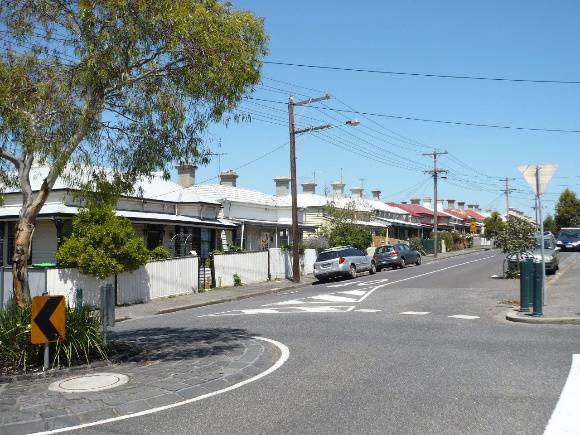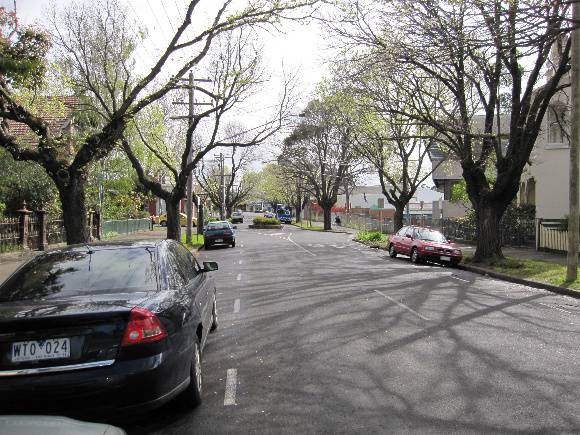| Back to search results » | Back to search page » |
|
Wellington Street
Other NamePrecinct LocationBIGNELL ST, BRIGHTON ST, BRIXTON ST, BRYANT ST, CHURCH ST, DALGLEISH ST, ELTHAM ST, FARNHAM ST, FINSBURY ST, KENT ST, LEE ST, MARWICK ST, LEWIS ST, NORWOOD PL, NORWOOD ST, PIN OAK CR, PRINCES ST, SHIELDS ST, WALTHAM ST and WELLINGTON ST, FLEMINGTON LevelIncluded in Heritage Overlay |
|
Statement of Significance
What is significant? The following elements contribute to the significance of the precinct: 1. The houses (and some shops and residences), and any associated early/original front fences, as appropriate at: - 1 High Street - 2-12 Bignall Street 2. The group of civic and community buildings comprising the Flemington Post Office at 2a Wellington Street, former Court House, Police Station & Lock-up at 28-30 Wellington Street, former Masonic temple at 9 Wellington Street, St Brendan's Church complex at 83-103 Wellington Street, Presbyterian Church at 28-40 Norwood Street, the 1896 former Fire Station at 59-61 Wellington Street, and the former Baptist Church at 12 Brighton Street. 3.The shops and residences at: Key attributes that contribute to the significance of this precinct include: - the consistency of scale (one or two storey), form, siting (uniform or similar front and side setbacks), and original materials and detailing (face brick or render with iron or tiled hip or gable roof, verandah with cast iron or timber detailing) of the contributory residential buildings, which typically survive with a relatively intact presentation to the street. Other houses in the precinct, post-WWII fences, and non-original additions to contributory places (e.g. non-original shopfronts and awnings to shops and rear additions to houses) are not significant. How is it significant? Why is it significant? The precinct is socially significant for the extent to which the location of different housing types - generally working class housing in the lower streets (or smaller laneways) such as Victoria Street and Norwood Place with middle and upper class housing on the higher ground - illustrates how the class structure was reflected in the layout and development of suburban Melbourne into the twentieth century. (Criterion G) It is architecturally and aesthetically significant as an outstanding example of a nineteenth century suburban area, which is which is notable for consistency of built form and the relatively high degree of integrity to the main periods of development. Wellington Street, with its series of landmark civic buildings on key street corners and mature street trees is especially notable as one of the finest nineteenth century streetscapes in the municipality. (Criteria D & E)
The Wellington Street precinct in Flemington was mostly developed in the late nineteenth and early twentieth century with some infill development occuring during the inter-war era. Predominantly residential, it also contains a strip of double and single storey shops along Racecourse Road and part of Pin Oak Crescent, as well as a fine group of community and civic buildings including churchand school complex, and a former courthouse and post office along Wellington Street. The houses include Victorian and Edwardian terrace rows, villas and cottages, interspersed with inter-war houses and bungalows.
- 9-21 & 27-35 and 14-36 & 42-46 Brighton Street
- 1-23 and 2-26 Brixton Street
- 11-23 & 33-45 and 20-28, 32-46, 50-70 & 82-96 Bryant Street
- 7-9 and 2-12, 22-38 Church Street
- 2-24 Dalgleish Street
- 1-41& 2-8 & 16-38 Eltham Street
- 1-23, 31-35, 45, 47, 53-77 and 2-6, 10-46 Farnham Street
- 3-45 & 49 and 2-28 & 34-42 Finsbury Street
- 41-51, 61-73, 77, 79, 81- 85, 89-105 Kent Street
- 1, 3, 9-27& 2-28 Lee Street
- 1-23& 2-24 Marwick Street
- 1-19& 2-14 Lewis Street
- 7 Norwood Place
- 3-25& 2-24 Norwood Street
- 74-162, 186-200, 208-242 & 256-288 Pin Oak Crescent
- 7, 11-15, 37-79, 93-99, 103, 105, 113-133 and 14-20, 22A, 24-70, 76-88 & 92-110 Princes Street
- 1-15, 19, 21, 27, 51-85, 91, 93, 101-111& 10-110 Shields Street
- 1-5, 13, 15, 19-71& 10-46 Waltham Street
- 1-7, 15-47, 51, 63-71, 77, 107-115 & 123-165 and 2-26 & 32-62 Welllington Street
- 6-22 & 34-72 Pin Oak Crescent
- 262-268, 282, 284, 290-304, 304A, 316, 318 & 324-336 Racecourse Road.
- the landmark quality of civic and community buildings along Wellington Street, both individually and as a grouping within the precinct.
- the consistency of scale and siting of buildings and the relative intactness of the upper facades within the commercial centre.
- the high degree of intactness to the late nineteenth century and early twentieth century development dates in most streets
- original front fences and low height of fences to residential properties meaning that dwellings are visible from the street
- regular road alignments and allotment patterns resulting from the nineteenth century subdivision
- the absence of vehicle accommodation including driveways and crossovers
- the bluestone kerb and channel in various streets throughout the precinct, bluestone and unmade laneways, and mature street trees including Planes (Platanus sp.) and Elms (Ulmus sp.).
The Wellington Street precinct in Flemington is of local historic, architectural and aesthetic significance to the City of Moonee Valley.
It is historically significant as an area that illustrates the rapid development of Flemington as a self-contained suburb of Melbourne in the late nineteenth and early twentieth century. The consistency of built form and the extent to which the key phase of development is clearly apparent vividly illustrates the rapid and sustained development in this area during the boom years of the late nineteenth century. The historic importance of this area as the centre of Flemington is demonstrated by the commercial, civic and community buildings, which provide further evidence of the extent of development during the late nineteenth and early twentieth century. (Criterion A & D)
Group
Residential buildings (private)
Category
Residential Precinct





